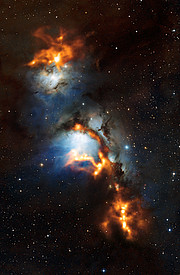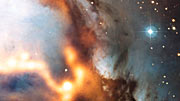Comunicato Stampa
La polvere della Cintura di Orione al setaccio
02 Maggio 2012
Una nuova immagine della regione che circonda la nebulosa a riflessione Messier 78, appena a nord della Cintura di Orione, mostra nubi di polvere cosmica intrecciate alla nebulosa come un filo di perle. Le osservazioni, effettuate con il telescopio APEX (Atacama Pathfinder Experiment) [1], sfruttano il calore prodotto dai grani di polvere interstellare per mostrare agli astronomi le zone in cui si formano nuove stelle.
La polvere può sembrare noiosa, poco interessante - la sporcizia superficiale che nasconde la bellezza di un oggetto. Ma questa nuova immagine di Messier 78 e dintorni, che svela la radiazione sub-millimetrica prodotta dai grani di polvere nello spazio, mostra che anche la polvere può essere abbagliante. La polvere è importante per gli astronomi poichè dense nubi di gase e polvere sono le culle di nuove stelle.
Nel centro dell'immagine si vede Messier 78, nota anche con il nome di NGC 2068. In luce visibile la regione appare come una nebulosa a riflessione, cioè vediamo il pallido riflesso della luce azzurra delle stelle, rimandato a noi dalle nubi di polvere. Le osservazioni di APEX, di colore aranciato, sono sovrapposte all'immagine in luce visibile. Sensibili a lunghezze d'onda maggiori, svelano il delicato brillio di densi grumi di polvere fredda, fino a -250ºC. Questa polvere risulta scura e opaca in luce visibile e questo è uno dei motivi per cui telescopi come APEX sono così importanti per studiare le nubi di polvere in cui nascono nuove stelle.
Un filamento visto da APEX appare in luce visibile come una striscia nera di polvere che attraversa Messier 78. Questo ci dice che le dense nubi di polvere si trovano davanti alla nebulosa, e ne bloccano la luce bluastra. Un'altra regione di polvere risplendente vista da APEX spicca nel bordo inferiore di Messier 78 osservato in luce visibile. La mancanza di una corrispondente striscia di polvere scura nelle immagini in luce visibile ci dice che questa regione densa di polvere deve trovarsi dietro alla nebulosa a riflessione.
Osservando il gas in queste nubi si rivelano flussi di gas ad alta velocità che fuoriescono da alcuni di questi grumi densi, esplusi da stelle giovani durante la loro formazione a partire dalle nubi circostanti. La loro presenza è perciò una dimostrazione che i grumi stanno attivamente formando stelle.
Nella parte superiore dell'immagine si vede un'altra nebulosa a riflessione, NGC 2071. Mentre la zona più in basso contiene solo stelle giovani e di piccola massa, NGC 2071 contiene una stella giovane più massiccia, circa cinque volte la massa del Sole, nel punto più brillante mostrato dalle osservazioni APEX.
Le osservazioni APEX usate per questa immagine sono state coordinate da Thomas Stanke (ESO), Tom Megeath (University of Toledo, USA), e Amy Stutz (Max Planck Institute for Astronomy, Heidelberg, Germania). Per ulteriori informazioni su come questa regione appare in luce visibile, inclusa la nebulosa McNeil recentemente scoperta - e molto variabile - si veda eso1105.
Note
[1] APEX è una collaborazione tra il Max Planck Institute for Radio Astronomy (MPIfR), l'Onsala Space Observatory (OSO) e l'ESO. La gestione di APEX a Chajnantor è affidata all'ESO. APEX è un precursore del telescopio di nuova generazione per onde submillimetriche, ALMA (Atacama Large Millimeter/submillimeter Array), in costruzione ma già operativo sullo stesso pianoro.
Ulteriori Informazioni
Nel 2012 cade il 50o anniversario della fondazione dell'ESO (European Southern Observatory, o Osservatorio Australe Europeo). L'ESO è la principale organizzazione intergovernativa di Astronomia in Europa e l'osservatorio astronomico più produttivo al mondo. È sostenuto da 15 paesi: Austria, Belgio, Brasile, Danimarca, Finlandia, Francia, Germania, Gran Bretagna, Italia, Olanda, Portogallo, Repubblica Ceca, Spagna, Svezia, e Svizzera. L'ESO svolge un ambizioso programma che si concentra sulla progettazione, costruzione e gestione di potenti strumenti astronomici da terra che consentano agli astronomi di realizzare importanti scoperte scientifiche. L'ESO ha anche un ruolo di punta nel promuovere e organizzare la cooperazione nella ricerca astronomica. L'ESO gestisce tre siti osservativi unici al mondo in Cile: La Silla, Paranal e Chajnantor. Sul Paranal, l'ESO gestisce il Very Large Telescope, osservatorio astronomico d'avanguardia nella banda visibile e due telescopi per survey. VISTA, il più grande telescopio per survey al mondo, lavora nella banda infrarossa mentre il VST (VLT Survey Telescope) è il più grande telescopio progettato appositamente per produrre survey del cielo in luce visibile. L'ESO è il partner europeo di un telescopio astronomico di concetto rivoluzionario, ALMA, il più grande progetto astronomico esistente. L'ESO al momento sta progettando l'European Extremely Large Telescope o E-ELT (significa Telescopio Europeo Estremamente Grande), della classe dei 40 metri, che opera nell'ottico e infrarosso vicino e che diventerà "il più grande occhio del mondo rivolto al cielo".
Links
Contatti
Thomas Stanke
ESO
Garching, Germany
Tel.: +49 89 3200 6116
E-mail: tstanke@eso.org
Douglas Pierce-Price
ESO ALMA/APEX Public Information Officer
Garching, Germany
Tel.: +49 89 3200 6759
E-mail: dpiercep@eso.org
Anna Wolter (press contact Italia)
Rete di divulgazione scientifica dell'ESO
e INAF-Osservatorio Astronomico di Brera
Milano, Italy
Tel.: +39 02 72320321
E-mail: eson-italy@eso.org
Sul Comunicato Stampa
| Comunicato Stampa N": | eso1219it |
| Nome: | M 78, Messier 78, NGC 2068, Orion |
| Tipo: | Milky Way : Nebula : Appearance : Reflection |
| Facility: | Atacama Pathfinder Experiment |
Our use of Cookies
We use cookies that are essential for accessing our websites and using our services. We also use cookies to analyse, measure and improve our websites’ performance, to enable content sharing via social media and to display media content hosted on third-party platforms.
ESO Cookies Policy
The European Organisation for Astronomical Research in the Southern Hemisphere (ESO) is the pre-eminent intergovernmental science and technology organisation in astronomy. It carries out an ambitious programme focused on the design, construction and operation of powerful ground-based observing facilities for astronomy.
This Cookies Policy is intended to provide clarity by outlining the cookies used on the ESO public websites, their functions, the options you have for controlling them, and the ways you can contact us for additional details.
What are cookies?
Cookies are small pieces of data stored on your device by websites you visit. They serve various purposes, such as remembering login credentials and preferences and enhance your browsing experience.
Categories of cookies we use
Essential cookies (always active): These cookies are strictly necessary for the proper functioning of our website. Without these cookies, the website cannot operate correctly, and certain services, such as logging in or accessing secure areas, may not be available; because they are essential for the website’s operation, they cannot be disabled.
Functional Cookies: These cookies enhance your browsing experience by enabling additional features and personalization, such as remembering your preferences and settings. While not strictly necessary for the website to function, they improve usability and convenience; these cookies are only placed if you provide your consent.
Analytics cookies: These cookies collect information about how visitors interact with our website, such as which pages are visited most often and how users navigate the site. This data helps us improve website performance, optimize content, and enhance the user experience; these cookies are only placed if you provide your consent. We use the following analytics cookies.
Matomo Cookies:
This website uses Matomo (formerly Piwik), an open source software which enables the statistical analysis of website visits. Matomo uses cookies (text files) which are saved on your computer and which allow us to analyze how you use our website. The website user information generated by the cookies will only be saved on the servers of our IT Department. We use this information to analyze www.eso.org visits and to prepare reports on website activities. These data will not be disclosed to third parties.
On behalf of ESO, Matomo will use this information for the purpose of evaluating your use of the website, compiling reports on website activity and providing other services relating to website activity and internet usage.
Matomo cookies settings:
Additional Third-party cookies on ESO websites: some of our pages display content from external providers, e.g. YouTube.
Such third-party services are outside of ESO control and may, at any time, change their terms of service, use of cookies, etc.
YouTube: Some videos on the ESO website are embedded from ESO’s official YouTube channel. We have enabled YouTube’s privacy-enhanced mode, meaning that no cookies are set unless the user actively clicks on the video to play it. Additionally, in this mode, YouTube does not store any personally identifiable cookie data for embedded video playbacks. For more details, please refer to YouTube’s embedding videos information page.
Cookies can also be classified based on the following elements.
Regarding the domain, there are:
- First-party cookies, set by the website you are currently visiting. They are stored by the same domain that you are browsing and are used to enhance your experience on that site;
- Third-party cookies, set by a domain other than the one you are currently visiting.
As for their duration, cookies can be:
- Browser-session cookies, which are deleted when the user closes the browser;
- Stored cookies, which stay on the user's device for a predetermined period of time.
How to manage cookies
Cookie settings: You can modify your cookie choices for the ESO webpages at any time by clicking on the link Cookie settings at the bottom of any page.
In your browser: If you wish to delete cookies or instruct your browser to delete or block cookies by default, please visit the help pages of your browser:
Please be aware that if you delete or decline cookies, certain functionalities of our website may be not be available and your browsing experience may be affected.
You can set most browsers to prevent any cookies being placed on your device, but you may then have to manually adjust some preferences every time you visit a site/page. And some services and functionalities may not work properly at all (e.g. profile logging-in, shop check out).
Updates to the ESO Cookies Policy
The ESO Cookies Policy may be subject to future updates, which will be made available on this page.
Additional information
For any queries related to cookies, please contact: pdprATesoDOTorg.
As ESO public webpages are managed by our Department of Communication, your questions will be dealt with the support of the said Department.







